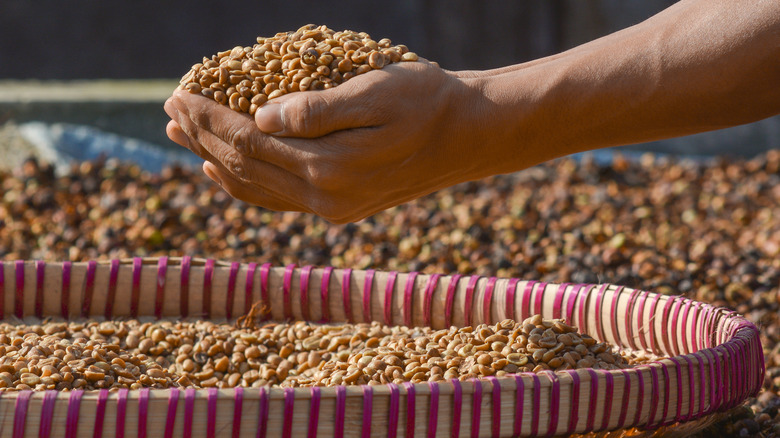Here's What Makes Koji-Fermented Coffee Unique
Arguably one of the most popular beverages being consumed around the world, coffee is having a bit of a renaissance period in the modern era. Never has there been more coffee shops and cafes that are dedicated to serving up the perfect "cup of joe," and the options for what types of beans are available and how a cup of coffee can best be enjoyed seem endless.
Another factor that is driving the global obsession with coffee is a demand for transparency about how our coffee is being produced. Consumers want to know geographically where the beans come from, whether or not they are ethically farmed, sustainably produced, eco-friendly, and if they offer any unique health benefits that make them superior to a basic cup of coffee. While many foods and beverage fads have come and gone, there is a new type of coffee that is primed to be the next big coffee trend in 2022, and that is Koji-fermented coffee (via MT Pak Coffee). Keep reading to find out exactly what makes this coffee so special and learn why it is something worth getting your hands on.
What exactly is koji-fermented coffee?
Koji-fermented coffee is fairly new on the market and is being touted as an alternative to the exorbitantly expensive cat poo (Kopi luwak or civet coffee), and elephant poo (Black Ivory Coffee) coffee that is produced in Southeast Asia. Hardcore coffee aficionados will know that both types of coffee are similarly made by feeding fresh coffee berries to mammals who digest the beans, ferment them in their stomachs, and then defecate out the beans. They are then further processed to make a smoother, less bitter coffee that is highly prized (via NPR).
According to Forbes, bio-scientist Koichi Higuchi, is credited with being the first to make koji-fermented coffee by applying koji spores to green coffee beans and then allowing them to ferment for a few days. "The idea of koji-fermented coffee came out of a conversation with my friend who is a coffee aficionado," Higuchi said. "We heard about the cat poop coffee, which is half-digested by cats' enzymes." Koji-fermented coffee takes the mammal out of the entire equation and instead uses koji (aspergillus oryzae) mold to ferment the coffee beans. As the outlet explained, this is the same mold that has been used for centuries in Japan to make traditional food such as miso, sake, and soy sauce.
What does koji-fermented coffee taste like?
One of the things that makes koji-fermented coffee so unique is the flavor profiles that are developed during the fermentation process. Roosa Jalonen, production lead for The Gentlemen Baristas in London, had this to say in an article with MT Pak Coffee: "El Vergel Estate in Colombia did some testing and they had some great results with this processing method. Apparently, it increased the cup score by at least one point and, in some cases, between two and two-point-five."
Once roasted, the coffee beans yield a lighter, less acidic cup of coffee with a smooth and mild finish. Inventor Higuchi continues to experiment with the process and is looking for even more new and exciting ways to improve the flavor. "Despite the critical importance of koji, there are only [six] companies that sell koji spores in the entire nation of Japan... We are trying to invent new products at our science lab, such as koji syrup to feature the natural sweetness of koji, made with rice and koji spores," he told Forbes. Whether a fad or a glimpse into the future, we certainly hope that koji-fermented coffee is a unique coffee that is here to stay.


